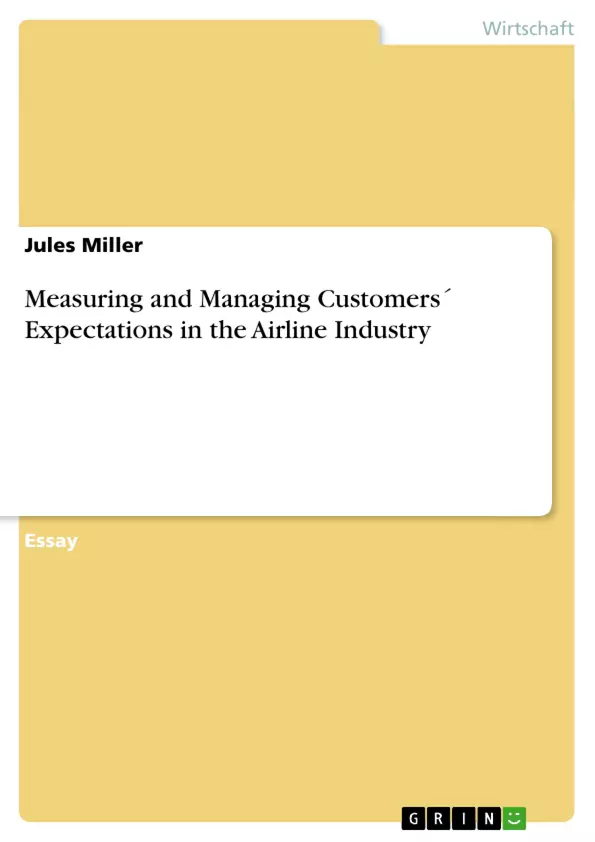Understanding and well managing customer’s needs and expectations is very critical for a service-oriented organization like an airline because it protects against customer’s dissatisfaction. After customers’ needs and expectations are well identified, the service provider should strive so as to fill the service quality gap and even to go beyond customers’ expectations by accommodating or shaping them. SERVQUAL is one of the measuring tools which has been widely used to measure customers’ expectations in the service quality setting. SERVQUAL represents service quality as the discrepancy between customer’s expectations for a service offering and the customer’s perception of the service received, requiring respondents to provide answers to questions related to both expectations and their perceptions. In order to manage effectively and efficiently customers’ expectations, airlines need to know them then accommodate them through segmentation, innovation and Total Quality Management or shape them by using communication and other cues such as customer-oriented human resources management practices but without promising more than they can deliver.
Inhaltsverzeichnis
- Einleitung
- Messung der Kundenerwartungen im Dienstleistungsmarketing
- Management der Kundenerwartungen in der Airline-Industrie
Zielsetzung und Themenschwerpunkte
Dieser Essay untersucht die Messung und das Management von Kundenerwartungen in der Airline-Industrie. Die Hauptziele sind die Analyse der Bedeutung von Kundenerwartungen für den Erfolg von Fluggesellschaften und die Darstellung von Methoden zur Messung und zum Management dieser Erwartungen im Kontext des Dienstleistungsmarketings.
- Die Bedeutung von Kundenerwartungen für die Servicequalität in der Airline-Industrie
- Methoden zur Messung der Kundenerwartungen (z.B. SERVQUAL)
- Die Rolle von Kundenzufriedenheit und -loyalität
- Strategien zum Management von Kundenerwartungen
- Der Einfluss von Servicequalität auf den Unternehmenserfolg
Zusammenfassung der Kapitel
Einleitung: Der Essay beginnt mit einer Schilderung der Krise der Airline-Industrie in den frühen 1990er Jahren und betont die Notwendigkeit von Anpassungen zur Sicherung des langfristigen Erfolgs. Er führt in die Thematik der Messung und des Managements von Kundenerwartungen im Dienstleistungsmarketing und deren Relevanz für die Airline-Industrie ein. Der Fokus liegt auf dem Verständnis der Kundenbedürfnisse und der Schließung der Lücke zwischen Kundenerwartungen und Airline-Performance.
Messung der Kundenerwartungen im Dienstleistungsmarketing: Dieses Kapitel definiert den Begriff "Dienstleistung" und "Qualität" und betont die Bedeutung der Servicequalität als Eckpfeiler des Geschäftserfolgs von Fluggesellschaften. Es wird erläutert, wie Kunden die Servicequalität definieren und wie wichtig es ist, ihre Erwartungen zu verstehen und zu erfüllen, um langfristige Kundenbeziehungen aufzubauen. Das Kapitel beschreibt die Unterscheidung zwischen technischer und funktionaler Servicequalität nach Gronroos und die Rolle von Kundenerwartungen als Bewertungsmaßstab für die Leistung von Unternehmen. Die SERVQUAL-Methode wird als ein Werkzeug zur Messung der Diskrepanz zwischen Kundenerwartungen und -wahrnehmungen vorgestellt.
Schlüsselwörter
Kundenerwartungen, Servicequalität, Airline-Industrie, Dienstleistungsmarketing, SERVQUAL, Kundenzufriedenheit, Kundenloyalität, Gap-Modell, Messmethoden, Managementstrategien.
Häufig gestellte Fragen zum Essay: Messung und Management von Kundenerwartungen in der Airline-Industrie
Was ist der Gegenstand dieses Essays?
Der Essay befasst sich mit der Messung und dem Management von Kundenerwartungen in der Airline-Industrie. Er analysiert die Bedeutung dieser Erwartungen für den Erfolg von Fluggesellschaften und präsentiert Methoden zur Messung und zum Management dieser Erwartungen im Kontext des Dienstleistungsmarketings.
Welche Themen werden im Essay behandelt?
Der Essay behandelt folgende Themen: die Bedeutung von Kundenerwartungen für die Servicequalität in der Airline-Industrie; Methoden zur Messung der Kundenerwartungen (z.B. SERVQUAL); die Rolle von Kundenzufriedenheit und -loyalität; Strategien zum Management von Kundenerwartungen; und den Einfluss von Servicequalität auf den Unternehmenserfolg.
Wie ist der Essay strukturiert?
Der Essay beinhaltet eine Einleitung, Kapitel zur Messung von Kundenerwartungen im Dienstleistungsmarketing und zum Management von Kundenerwartungen in der Airline-Industrie. Er bietet außerdem eine Zusammenfassung der einzelnen Kapitel und nennt Schlüsselwörter.
Welche Methode zur Messung von Kundenerwartungen wird im Essay vorgestellt?
Der Essay präsentiert die SERVQUAL-Methode als ein Werkzeug zur Messung der Diskrepanz zwischen Kundenerwartungen und -wahrnehmungen.
Welche Bedeutung haben Kundenerwartungen für Fluggesellschaften?
Kundenerwartungen sind ein Eckpfeiler des Geschäftserfolgs von Fluggesellschaften. Die Erfüllung dieser Erwartungen ist entscheidend für die Servicequalität, Kundenzufriedenheit, Kundenloyalität und letztendlich den Unternehmenserfolg. Die Nichtbeachtung kann zu negativen Folgen führen.
Was wird in der Einleitung des Essays beschrieben?
Die Einleitung beschreibt die Krise der Airline-Industrie in den frühen 1990er Jahren und betont die Notwendigkeit von Anpassungen. Sie führt in die Thematik der Messung und des Managements von Kundenerwartungen im Dienstleistungsmarketing ein und unterstreicht deren Relevanz für die Airline-Industrie. Der Fokus liegt auf dem Verständnis der Kundenbedürfnisse und der Schließung der Lücke zwischen Kundenerwartungen und Airline-Performance.
Welche Schlüsselbegriffe sind im Essay relevant?
Die Schlüsselwörter sind: Kundenerwartungen, Servicequalität, Airline-Industrie, Dienstleistungsmarketing, SERVQUAL, Kundenzufriedenheit, Kundenloyalität, Gap-Modell, Messmethoden und Managementstrategien.
Was wird im Kapitel über die Messung von Kundenerwartungen im Dienstleistungsmarketing behandelt?
Dieses Kapitel definiert "Dienstleistung" und "Qualität" und betont die Bedeutung der Servicequalität. Es erläutert, wie Kunden die Servicequalität definieren und wie wichtig es ist, ihre Erwartungen zu verstehen und zu erfüllen. Die Unterscheidung zwischen technischer und funktionaler Servicequalität nach Gronroos und die Rolle von Kundenerwartungen als Bewertungsmaßstab werden erklärt.
- Citar trabajo
- Masters of Arts (Marketing) Jules Miller (Autor), 2011, Measuring and Managing Customers´ Expectations in the Airline Industry, Múnich, GRIN Verlag, https://www.grin.com/document/180611



